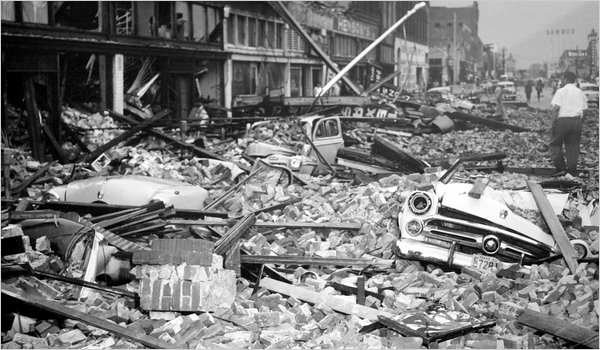A tornado outbreak in Waco, Texas kills 114 people.
The 1953 Waco tornado outbreak was a series of at least 33 tornadoes occurring in 10 different U.S. states on May 9–11, 1953. Tornadoes appeared daily from Minnesota in the north to Texas in the south. The strongest and deadliest tornado of the severe weather event was a powerful F5 on the Fujita scale.[nb 1] It struck Waco, Texas, on May 11, causing 114 of the 144 deaths in the outbreak. Alongside the 1902 tornado in Goliad, it was the deadliest tornado in Texas history and is the eleventh deadliest tornado in U.S. history. The tornado’s winds demolished more than 600 houses, 1,000 other structures, and over 2,000 vehicles. Nearly 600 injuries occurred, and many survivors had to wait over 14 hours for rescue. The destruction dispelled a myth that the geography of the region spared Waco from tornadoes, and along with other deadly tornadoes in 1953, the Waco disaster was a catalyst for advances in understanding the link between tornadoes and radar-detected hook echoes. It also generated support for improved civil defense systems, the formation of weather radar networks, and improved communications between stakeholders such as meteorologists, local officials, and the public.
2Time from first tornado to last tornado
The 1953 Waco tornado outbreak was a series of at least 33 tornadoes occurring in 10 different U.S. states on May 9–11, 1953. Tornadoes appeared daily from Minnesota in the north to Texas in the south. The strongest and deadliest tornado of the severe weather event was a powerful F5 on the Fujita scale. It struck Waco, Texas, on May 11, causing 114 of the 144 deaths in the outbreak. Alongside the 1902 tornado in Goliad, it was the deadliest tornado in Texas history and is the eleventh deadliest tornado in U.S. history. The tornado’s winds demolished more than 600 houses, 1,000 other structures, and over 2,000 vehicles. Nearly 600 injuries occurred, and many survivors had to wait over 14 hours for rescue. The destruction dispelled a myth that the geography of the region spared Waco from tornadoes, and along with other deadly tornadoes in 1953, the Waco disaster was a catalyst for advances in understanding the link between tornadoes and radar-detected hook echoes. It also generated support for improved civil defense systems, the formation of weather radar networks, and improved communications between stakeholders such as meteorologists, local officials, and the public.The Waco tornado was not the only deadly and damaging tornado in the outbreak sequence. On the same day as the Waco disaster, a high-end F4 tornado struck the Texas city of San Angelo, causing catastrophic damage, killing 13 people, and injuring more than 150. The tornado swept away numerous homes and damaged a school, but students inside escaped serious injuries. On May 9, a long-tracked F3 tornado destroyed a large swath of Hebron, Nebraska, and killed five people in the area. The following day, May 10, featured numerous, often long-tracked and intense tornado families across the states of Iowa, Minnesota, and Wisconsin. Two families on nearly parallel paths traveled more than 100 miles each and killed a combined total of six people, mostly in Wisconsin. At least one of the tornado families reached F4 intensity in Wisconsin. Two other F4 tornadoes also struck Iowa. Additionally, a relatively moderate tornado of F2 intensity caused significant loss of life in a shack in Minnesota, killing six people. Although 33 tornadoes were officially registered from May 9–11, others likely occurred but either went undetected or were not officially documented.

